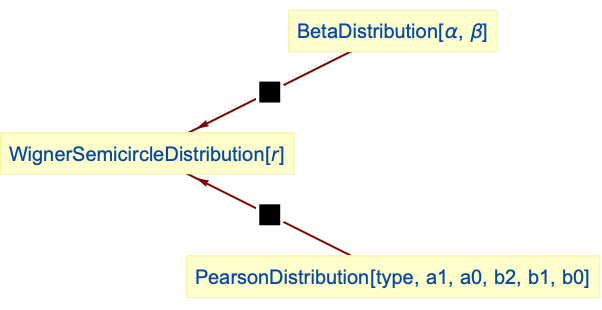WignerSemicircleDistribution
WignerSemicircleDistribution[r]
represents a Wigner semicircle distribution with radius r centered at the origin.
WignerSemicircleDistribution[a,r]
represents a Wigner semicircle distribution with radius r centered at a.
Details
- The probability density for value
 in a Wigner semicircle distribution is proportional to
in a Wigner semicircle distribution is proportional to  for
for  between
between  and
and  .
. - WignerSemicircleDistribution allows a to be any real number and r to be any positive real number.
- WignerSemicircleDistribution allows a and r to be any quantities of the same unit dimensions. »
- WignerSemicircleDistribution can be used with such functions as Mean, CDF, and RandomVariate.
Background & Context
- WignerSemicircleDistribution[a,r] represents a continuous statistical distribution supported over the interval
 that is parametrized by a real number a (the center of the distribution) and a positive real number r (its radius), which together determine the overall behavior of its probability density function (PDF). In general, the PDF of a Wigner semicircle distribution is shaped like an ellipse and hence is unimodal with a single "peak" (i.e. a global maximum), though its overall shape (its height, its spread, and the horizontal location of its maximum) is determined by the values of a and r. The one-parameter form WignerSemicircleDistribution[r] is equivalent to WignerSemicircleDistribution[0,r]. In general, the Wigner semicircle distribution may be referred to as Wigner's semicircle, the Sato–Tate distribution, or simply as the Wigner distribution.
that is parametrized by a real number a (the center of the distribution) and a positive real number r (its radius), which together determine the overall behavior of its probability density function (PDF). In general, the PDF of a Wigner semicircle distribution is shaped like an ellipse and hence is unimodal with a single "peak" (i.e. a global maximum), though its overall shape (its height, its spread, and the horizontal location of its maximum) is determined by the values of a and r. The one-parameter form WignerSemicircleDistribution[r] is equivalent to WignerSemicircleDistribution[0,r]. In general, the Wigner semicircle distribution may be referred to as Wigner's semicircle, the Sato–Tate distribution, or simply as the Wigner distribution. - The Wigner semicircle distribution is named for Hungarian-American scientist Eugene Wigner, whose 1955 treatise on infinite random matrices showed the importance of the distribution within the context of random matrix theory. The Wigner semicircle distribution is the statistical foundation of the so-called Wigner semicircle law, which states that the eigenvalues of a certain class of random matrices arising in quantum mechanics are Wigner distributed, Many of the applications of the distribution are related to phenomena in statistical quantum mechanics and various subfields of mathematics, including linear algebra, Fourier series, and spectral analysis.
- RandomVariate can be used to give one or more machine- or arbitrary-precision (the latter via the WorkingPrecision option) pseudorandom variates from a Wigner distribution. Distributed[x,WignerSemicircleDistribution[a,r]], written more concisely as xWignerSemicircleDistribution[a,r], can be used to assert that a random variable x is distributed according to a Wigner distribution. Such an assertion can then be used in functions such as Probability, NProbability, Expectation, and NExpectation.
- The probability density and cumulative distribution functions for Wigner distributions may be given using PDF[WignerSemicircleDistribution[a,r],x] and CDF[WignerSemicircleDistribution[a,r],x]. The mean, median, variance, raw moments, and central moments may be computed using Mean, Median, Variance, Moment, and CentralMoment, respectively.
- DistributionFitTest can be used to test if a given dataset is consistent with a Wigner distribution, EstimatedDistribution to estimate a Wigner parametric distribution from given data, and FindDistributionParameters to fit data to a Wigner distribution. ProbabilityPlot can be used to generate a plot of the CDF of given data against the CDF of a symbolic Wigner distribution, and QuantilePlot to generate a plot of the quantiles of given data against the quantiles of a symbolic Wigner distribution.
- TransformedDistribution can be used to represent a transformed Wigner distribution, CensoredDistribution to represent the distribution of values censored between upper and lower values, and TruncatedDistribution to represent the distribution of values truncated between upper and lower values. CopulaDistribution can be used to build higher-dimensional distributions that contain a Wigner distribution, and ProductDistribution can be used to compute a joint distribution with independent component distributions involving Wigner distributions.
- WignerSemicircleDistribution is related to a number of other distributions. It is generalized by PearsonDistribution, in the sense that the PDF of WignerSemicircleDistribution[r] is precisely the same as that of PearsonDistribution[1,1,0,-1,0,r] for r>0. Similarly, WignerSemicircleDistribution can be realized as a transformation (TransformedDistribution) of BetaDistribution, while PDF[WignerSemicircleDistribution[r],x] tends to DiracDelta[x] as r→0. WignerSemicircleDistribution is also related to VonMisesDistribution and BetaPrimeDistribution.
Examples
open allclose allBasic Examples (4)
Scope (7)
Generate a sample of pseudorandom numbers from a Wigner semicircle distribution:
Compare its histogram to the PDF:
Distribution parameters estimation:
Estimate the distribution parameters from sample data:
Compare the density histogram of the sample with the PDF of the estimated distribution:
Skewness and kurtosis are constant:
Different moments with closed forms as functions of parameters:
Closed form for symbolic order:
Closed form for symbolic order:
Consistent use of Quantity in parameters yields QuantityDistribution:
Applications (1)
Illustrate universality conjecture of the Wigner semicircle law asserting that spectral density of large symmetric matrices, formed from independent identically distributed random variables with zero mean and finite variance, converges to PDF of WignerSemicircleDistribution:
Sample the spectrum of matrices with elements drawn from Student ![]() distribution:
distribution:
Use method of moments to fit WignerSemicircleDistribution to the sample:
The conjecture does not hold for distributions whose variance is not finite:
Properties & Relations (4)
The WignerSemicircleDistribution is closed under translation and scaling by a positive factor:
Relationships to other distributions:

Wigner semicircle distribution is a special case of type 1 PearsonDistribution:
Wigner semicircle distribution is a transformation of special BetaDistribution:
Text
Wolfram Research (2010), WignerSemicircleDistribution, Wolfram Language function, https://reference.wolfram.com/language/ref/WignerSemicircleDistribution.html (updated 2016).
CMS
Wolfram Language. 2010. "WignerSemicircleDistribution." Wolfram Language & System Documentation Center. Wolfram Research. Last Modified 2016. https://reference.wolfram.com/language/ref/WignerSemicircleDistribution.html.
APA
Wolfram Language. (2010). WignerSemicircleDistribution. Wolfram Language & System Documentation Center. Retrieved from https://reference.wolfram.com/language/ref/WignerSemicircleDistribution.html